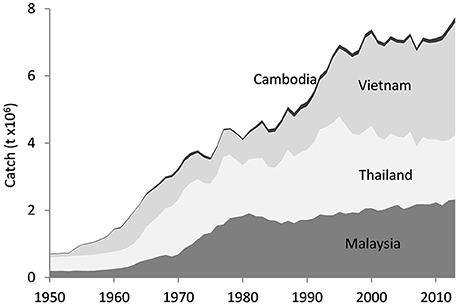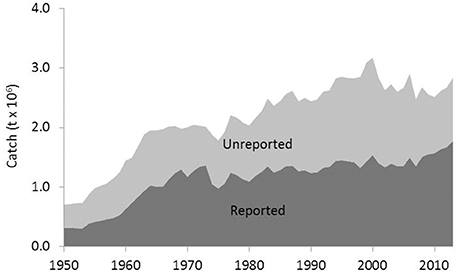- Sea Around Us, Institute for the Oceans and Fisheries, The University of British Columbia, Vancouver, BC, Canada
Amidst overexploited fisheries and further climate related declines projected in tropical fisheries, marine dependent small-scale fishers in Southeast Asia face an uncertain future. Yet, small-scale fishers are seldom explicitly considered in regional fisheries management and their contribution to national fish supply tends to be greatly under-estimated compared to industrial fisheries. Lack of knowledge about the small-scale sector jeopardizes informed decision-making for sustainable ecosystem based fisheries planning and social development. We fill this knowledge gap by applying reconstructed marine fish catch statistics from Cambodia, Malaysia, Thailand, and Vietnam—countries of the Gulf of Thailand—from 1950 to 2013 to assess the relative contribution of small-scale and industrial fisheries to national food security. Reconstructed catches quantify reported and unreported fish catch from industrial, small-scale, and recreational fishing. We then conduct a comparative analysis of the degree to which the industrial and small-scale sectors support food security, by converting total catch to the portion that is kept for human consumption and that which is diverted to fishmeal for animal feed or other purposes. Total reconstructed marine fish catch from the four Southeast Asian countries totalled 282 million t from 1950 to 2013, with small-scale sector catches being underestimated by an average of around two times. When the amount of fish that is diverted to fishmeal is omitted, small-scale fishers contribute more food fish for humans than do industrial fisheries for much of the period until 2000. These results encourage regional fisheries management to be cognisant of small-scale fisheries as a pillar of socio-economic well-being for coastal communities.
Introduction
Small-scale inshore fisheries are the backbone of socio-economic well-being in coastal communities throughout the world (Béné, 2006; Harvey, 2006; Teh and Sumaila, 2013), particularly in the tropics where the majority of countries with heavily fish dependent populations are situated (Golden et al., 2016). In these locations, fish is crucial for food security and health, providing not only daily protein requirements, but also a range of essential micronutrients that fend off diseases of malnutrition. The importance of fish to society is more so given that it is relied upon by some of society's most vulnerable groups, including the poor and stateless migrants, who might otherwise have no other means of livelihood (Béné et al., 2007, 2010). Fisheries in the tropics are predicted to fall by as much as 30% by 2050 as a result of global ocean warming and changes in net primary production (Cheung et al., 2016). Despite this abject negative outlook, national governments are not well-prepared to deal with its potential socio-ecological outfalls, not least due to glaring gaps in knowledge about the magnitude and nature of small-scale fisheries (Pauly, 1997, 2006; van Zwieten et al., 2002). There is thus a very real and urgent need to assess the role of small-scale fisheries, and to translate this knowledge to timely and relevant policies on sustainable fisheries and marine management for food security (Teh et al., 2007; Barnes-Mauthe et al., 2013).
The definition and terminology for small-scale fishers varies from country to country (Table 1). In Malaysia, small-scale fisheries are most consistent with traditional fisheries which include those fishers who use traditional gears such as hook-and-line, bagnets, traps, lift nets, seine nets, barrier nets, and scoop nets. In Vietnam, fisheries are commonly classified as near-shore and offshore rather than as small and large scale (Pomeroy et al., 2009), while in Cambodia the term coastal fisheries is used, and involves family-scale fishing units operating from the coast to a depth of 20 m (FAO, 2011b). Thailand's Department of Fisheries' definition is based on boat gross tonnage, whereby small-scale is defined as inboard powered boats of less than 10 GT, and that generally operate inshore. For the purpose of this study, we define small-scale fisheries as those that exhibit some or all of the following characteristics: (i) primarily geared toward household consumption, sale at the local level, or export in the case of high value species; (ii) usually at low level (primary and secondary) of economic activity; (iii) for fulfilling cultural or ceremonial purposes; (iv) non-mechanized, or involve low technology and low capital investment; (v) undertaken by the fisher and/or family members only; (vi) conducted within inshore areas; and (vii) minimally managed (Teh and Sumaila, 2013). We consider industrial fisheries to be large-scale, commercial fishing operations that involve substantial capital investment and take place in coastal or offshore fishing grounds, in which fishing is typically carried out by a crew and lasts from days to months at a time.

Table 1. Description of fisheries that are considered industrial and small-scale in each of the four studied countries, and their coverage in national fisheries statistics.
Small-scale fisheries in Southeast Asia (SEA) tend to be overshadowed by the large-scale commercial (industrial) sector, which, due to a larger fishing capacity, has historically been favored by governments as the more efficient method of marine resource exploitation. Starting with the introduction of trawling in the mid-20th century, first in Thailand then Malaysia, governments rapidly expanded the fishing power of their industrial fleets in the “race for fish” toward national social and economic development objectives (Morgan and Staples, 2006). These fisheries generated national income, supplied food to feed the country, and provided local jobs that were ironically supposed to benefit poor fishing households, i.e., small-scale fishers. Yet, the concerns of small-scale fishers were considered secondary or even completely overlooked at the national level (van Zwieten et al., 2002; Pauly, 2006). Tellingly, small-scale fishers and their catch are largely unaccounted for in the fisheries statistics of many countries, including Vietnam and Cambodia (van Zwieten et al., 2002; Pomeroy et al., 2009; Teh et al., 2016b,c), or greatly under-represented in others such as Thailand and Malaysia (Teh and Teh, 2016; Teh et al., 2016a) (Table 1).
The biased investment in industrial fisheries has resulted in overfishing throughout Southeast Asia—in the Gulf of Thailand, demersal fish stocks in the 1990s had fallen to just one tenth of their levels in the mid-1960s when trawling began (FAO, 1997). The depletion of inshore fish stocks has often come at the socio-economic expense of small-scale fishers (Panayotou, 1980; Salayo et al., 2006), many of whom have limited control over marine resource access issues (but see Kurien, 2004). Up to now, the disparity between industrial and small-scale sector catches has not been easily quantified due to inconsistent or lack of accounting of small-scale catches. Small-scale fisheries are notoriously hard to quantify. Often, they take place in rural areas that may be remote and difficult to monitor, but even in urban areas small-scale fisheries can be poorly monitored due to low prioritization and budgetary constraints (Pauly, 1997; Béné et al., 2010). Ignorance also plays a role, as activities such as gleaning by women and children have until recently not been recognized for their important role in securing household food and nutritional requirements (Harper et al., 2013).
The objective of this paper is to assess the relative contribution of the industrial and small-scale fishing sectors to national food security. We do this by analyzing previously reconstructed marine fisheries catch data from four countries that border the Gulf of Thailand—Vietnam, Cambodia, Thailand, and Malaysia—for the period 1950 to 2013, and estimating the proportion of fish catch from each sector that is available directly for humans' consumption.
Methods
The historical reconstruction of fisheries catch statistics for Cambodia (Teh et al., 2014a), Malaysia (Teh and Teh, 2014), Thailand (Teh et al., 2015), and Vietnam (Teh et al., 2014b) estimated total fish catch from each country's EEZ in the period 1950 to 2010 that were caught by their domestic fishing fleet, by adding unreported catch to officially reported fish landings. Reported fish landings were typically extracted from the FAO's fisheries statistics database while unreported catches from small-scale (artisanal and subsistence), industrial, and recreational fishing were estimated by synthesizing data from a variety of literature. As each of the four countries' detailed catch reconstruction methods are explained elsewhere (Teh and Teh, 2014; Teh et al., 2014a,b, 2015), we have not reproduced them in this paper. Rather, we briefly describe how unreported fish catches were estimated in each country's fishing sectors (Table 2).
Industrial Sector
Unreported industrial catch was estimated by raising reported landings by a multiplier which reflects the level of illegal, unregulated, or unmonitored fishing. In Thailand, 20% was added to catches of demersal fisheries to account for unreported industrial catch (Teh et al., 2015), while in Vietnam, total landings were raised by an unreported catch ratio of 1.9 (Teh et al., 2014b). In Cambodia, “A significant amount of the marine catch is transferred to foreign vessels at sea and is not landed in Cambodia” FAO (2017), with suggestions that up to 80% of marine fish catch is sold at sea and not reported (Chansothea et al., 2007; FAO, 2011a). Reported landings were thus raised by a factor of 4 during years when fisheries management was minimal (1960–1990), after which the percentage of catch sold at sea was linearly decreased to 25% in 2000 and then held constant to the end of the catch reconstruction period (Teh et al., 2014a). Unreported industrial fish catch in Malaysia was based on the fishing effort of unlicensed trawlers. The catch by unlicensed (unreported) trawlers was derived by applying an unlicensed to licensed ratio to the number of licensed trawlers. There were an estimated 452 unlicensed, as opposed to 138 licensed trawlers operating in Peninsular Malaysia in 1966 (Anon, 1968). This generates an unlicensed to licensed ratio of 3.28, which was used as the starting anchor point in 1964, the year that industrial sector catches were first accounted for in the catch reconstruction. Thereafter, anchor points were 5.06 and 1.46 in 1967 and 1998 respectively. Intervening years between anchor points were linearly interpolated, and the 1998 anchor point was carried forward to 2010 due to reports of ongoing unlicensed fishing by trawlers along the East Coast in the mid-2000s (Anon, 2008).
Small-Scale Sector
Two methods were used generally, one based on fish consumption and the other on fishing effort. The fish consumption method estimated catch by assuming that small-scale fishing was supplying at least enough fish to feed the coastal population. Thus, fish catch was estimated by multiplying coastal population by a fish consumption rate. This approach was typically used in the earlier reconstruction periods when local fisheries were less commercialized. For example, in Malaysia the fish consumption method was used from 1950 to 1965. Thereafter, fishers were assumed to have become more market oriented and increased production levels, and the small-scale catch estimation was accordingly adjusted to the fishing effort method. Similarly, small-scale fishing in Cambodia was assumed to be mostly subsistence based from 1950–1980, during which the fish consumption method was used. The fishing effort method estimated total catch by multiplying the number of fishers or boats with a catch rate to derive a time series of catch. Appendix 1 in Supplementary Materials provides more information on the methods used to estimate unreported small-scale sector catch.
Discards
Fish discarded at sea are treated as part of industrial catch, and were generally estimated by applying a discard rate to total industrial (reported and unreported) catch. Fish discards tend to be low value fish which have no commercial value or are too small to be eaten. Fish discarding in Southeast Asia is generally low because of existing markets for fertilizer and fishmeal, which use low value fish as inputs. Discard rates were primarily extracted from a study on fish discarding practices in marine fisheries around the world (Kelleher, 2005). In Cambodia, a discard rate of 1% (Kelleher, 2005) of industrial catch was used starting in the mid-1990s. In Thailand, the discard rate was linearly decreased from 22% (Kungsawan, 1996) of total catch in the 1960s when industrial trawling began to 1% (Kelleher, 2005) by 2000. In Vietnam, only large trawlers that operate offshore for several days discard low value fish (Long, 2003), which made up about 50–60% of their total catch (Long, 2003). We treated these as the amount of fish discarded at sea. In Peninsular Malaysia, fish discards was estimated based on the proportion of low value fish in landed catch, which averaged 30% from 1976 to 2010.
Recreational Catch
Recreational catch – recreational catch, which is defined as fish caught for leisure, was estimated for Thailand and Malaysia. This method will not be described here as it is not considered in this paper.
Reconstructed Fish Catch Statistics Extension to 2013
We updated reconstructed marine fish catch statistics from their ending year of 2010 to 2013. To calculate total reconstructed catch in 2011 and subsequent years, we adjusted the preceding year's catch by the percentage change in annual reported landings as reported by FAO in FishStatJ1.
In this study we use previously reconstructed catch data from 1950 to 2010, and extended catch data from 2010 to 2013, to estimate the quantity of industrial and small-scale fish catch that is used directly for human consumption.
Fishmeal Production
We used the quantity of catch that is channeled to fishmeal production as the proxy for the amount of fish used for non-human consumption. Trawl nets are the dominant gears that catch low value fish (LVF) that are processed into fishmeal (Pomeroy et al., 2007). Thus, we only used the quantity of catch from industrial trawlers in deriving the amount of fish for fishmeal. This was calculated as follows:
Where Cfishmeal is the amount of fish for non-human consumption, Cind is industrial sector catch, % trawl is the % of catch caught by trawl nets, % LVFtrawl is the % of trawl catch that is LVF, and % LVFfishmeal is the % of LVF used for fishmeal. The exception was Cambodia, for which, due to lack of data on % trawl and % LVFtrawl, we estimated Cfishmeal based on the reported percentage of trash fish in total marine catch.
The percentage of catch caught by trawl nets was estimated from national fisheries statistics that provided landings by gear type (Malaysia, Thailand), or from published literature (Vietnam). Data on the species composition of trawl catches were also obtained from national statistics and literature, and were used to derive the proportion of low value fish in trawl catches. The proportion of low value fish that is channeled toward fishmeal ranged from a high of 100% in Cambodia to 50% in Vietnam, where there are competing uses of low value fish for fishmeal and fish sauce production (Edwards et al., 2004). Anchor points of the parameters used to calculate fishmeal production are detailed in Appendix 2.
Data Uncertainty
The uncertainty associated with each catch reconstructions is addressed using a “pedigree” procedure (Pauly and Zeller, 2016). In this approach, the authors of each catch reconstruction evaluate the quality of the time series data in each fisheries sector over three time periods (1950–1969), 1970–1989, and 1990–2010) by assigning a score from a scale of 1 (very low) to 4 (very high). Each score has a percentage uncertainty range associated with it, as shown on Table 3. This same procedure was used by the Intergovernmental Panel on Climate Change to quantify uncertainty in its assessments (Mastrandrea et al., 2010). We then calculate the average of the uncertainty percentages across all sectors, time periods, and countries to generate the upper and lower bounds for uncertainty.
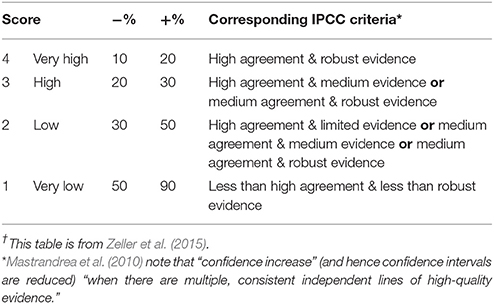
Table 3. “Score” for evaluating the quality of time series of reconstructed catches, with their confidence intervals (IPCC criteria from Figure 1 of Mastrandrea et al., 2010)†.
Results
Reconstructed marine fish catches from the industrial and small-scale (artisanal and subsistence) sectors, as well as recreational fishing, in Cambodia, Malaysia, Thailand, and Vietnam totalled about 282 million t from 1950 to 2013, averaging 972,000 t in the 1950s and increasing to 7.3 million t in the last decade (Figure 1, Appendix 3 in Supplementary Materials). Total reconstructed catch was about 1.7 times higher than the catch amount reported to the FAO on behalf of the four countries for the same time period, which we show with the average percentage uncertainty associated with the reconstructed catch (Figure 2). The highest contribution to total catch was made by Thailand with 37%, while at 2% Cambodia contributed the least (Figure 3). Highest under-reporting occurred in the 1950s when reconstructed catches were 2.3 times that of reported catch, then decreased to a level of 1.8 in the last decade. Small-scale catches were similarly under-reported by about two times across the catch reconstruction period (Figure 4). The proportion of small-scale sector catch fell from comprising almost all of total reconstructed catch in the 1950s to about 35% in 2013, with the largest drop observed in the 1960-1970 decade (Figure 5). Overall, industrial sector catch comprised 70% of total catches in Cambodia; 76% in Malaysia; 53% in Thailand; and 32% in Vietnam.
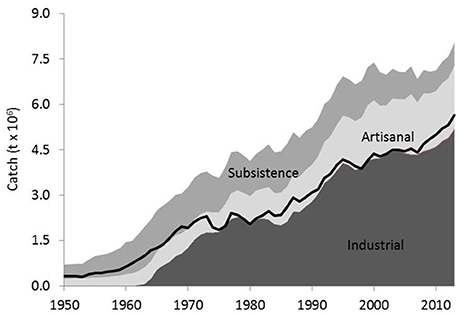
Figure 1. Total reconstructed catch of Cambodia, Malaysia, Thailand, and Malaysia showing the contribution of different sectors. The solid line indicates reported catch. Recreational catches are too small to appear on this graph.
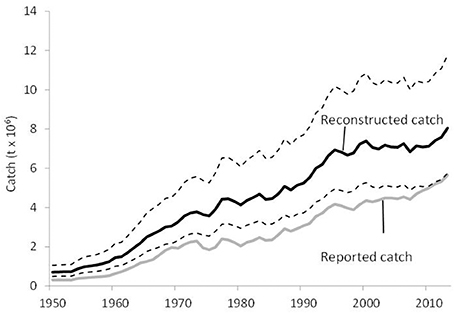
Figure 2. The mean weighted uncertainty (dashed lines) of total reconstructed catch. Uncertainty is based on data quality scores assigned to each country.
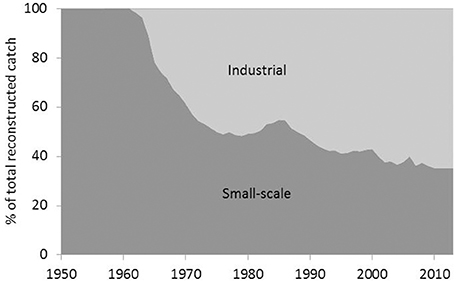
Figure 5. Percentage change in small-scale and industrial sector catch contribution from 1950 to 2013.
Small-scale fisheries, from being the main source of fish in the 1950s, were overtaken in the mid-1970s by industrial sector catches (with the exception of Vietnam, where the industrial sector did not take off until the late 1980s). Although much higher than small-scale catches, the contribution of industrial catch to local food security is not as great as initially appears to be when assessed by the proportion of industrial catch that is channeled toward human and non-human consumption, the latter as measured by catch amount used for fishmeal production. Across all four countries, the proportion of industrial catch used for fishmeal averaged 30%. When fishmeal is omitted, catch from the small-scale sector exceeds the portion of industrial catch that is consumed by people from 1950 until around 2000 (Figure 6).
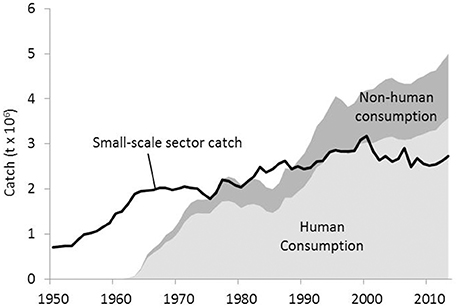
Figure 6. The proportion of industrial sector catch (aggregated across all four countries) that is used for human and non-human consumption (fishmeal). The solid line shows small-scale sector catch.
Depending on the fisheries sector and time period, the original reconstructed catch data were estimated with uncertainty ranges of between 20–50%, associated with high to low confidence in data quality.
Discussion
Throughout Southeast Asia small-scale fishing is vital for the well-being of coastal communities, where it provides food, informal employment, and income for some of the poorest and most marginalized segments of society (Béné, 2006; Pomeroy, 2012). Despite this, the contribution of small-scale fisheries is inherently overlooked by national governments. The reconstructed marine fisheries catch of Cambodia, Malaysia, Thailand, and Vietnam show clearly the significant contribution of this sector. For the first time, we quantified the amount of fish caught by small-scale fishers and find that they were the main providers of fish nationally until the rise of industrial fishing. Even when overtaken in terms of catch amount by the industrial sector, small-scale fisheries remain important at the community level where they act as social safety nets (Béné et al., 2007, 2010). Coastal dwellers in Southeast Asia, whose fish consumption rates are high (Needham and Funge-Smith, 2014), and especially those in rural or remote locations, rely on the catch brought in by small-scale fishers for meeting daily protein and micronutrient needs (Needham and Funge-Smith, 2014).
In each of the four countries, accelerated industrial sector catch coincided with national fisheries expansion plans after World War II which looked to fishing as a way to achieve food security and economic development. In Thailand the otter trawl was introduced as part of the government's National Economic and Social Development Plan in 1961 (Butcher, 2004). This paved the way for subsequent depletion of Thailand's inshore marine resources, and intensification of the “race for fish” in the Gulf of Thailand (Butcher, 2004). Fisheries expansion in Vietnam during the late 1950s to mid-1960s was supported by investments from the U.S. government (Butcher, 2004), while economic liberalization policies introduced in 1986 spurred rapid growth of the country's industrial fisheries (Pomeroy et al., 2009). In Malaysia, government investment in commercial fisheries through a series of National Economic Plans led to rapid growth in the number of trawlers and surge in industrial fish landings in the mid-1960s to 1970s (Butcher, 2004).
The rise of industrial fishing has come at the expense of small-scale fisheries, as small-scale catches from the four countries have declined from comprising 80% of total reconstructed catch in the mid-1960s to 35% in 2013. Reports of decreased catches in small-scale fisheries are common throughout Southeast Asia (Butcher, 2004; Morgan and Staples, 2006; Teh et al., 2007), a trend that is supported by this study. The overall decline in small-scale catches shown in this study concurs with fishers' perceptions of reduced catches regionally. In Thailand, small-scale fishers apparently were able to catch up to eight times as much fish in the 1980s compared to 2000s (Lunn and Dearden, 2006). In Vietnam, small-scale fishers perceived that fish catch had decreased by slightly over 40% over the span of the 2000s (Sinh and Long, 2011). Similarly, small-scale fishers in Cambodia experienced a marked reduction in catches in the 2000s (Doma, 2011). Not surprisingly, the unequal distribution of marine resources has been the root cause of on-going conflict between small-scale fishers and large commercial fishing operators across Southeast Asia (Salayo et al., 2006). When trawling started to expand in the 1960s, trawlers and traditional fishers got into violent confrontations over valuable shrimp stocks in in the Straits of Malacca (Butcher, 2004). Then, as now, indiscriminate trawling not only damaged small-scale gears but also crowded small-scale fishers out of their traditional fishing grounds (Pomeroy et al., 2007).
The higher catches obtained by industrial vessels do not translate to increased fish supply for human consumption. The conversion of low value fish to livestock feed and the negative implications of this practice for societal food security and fisheries sustainability is widely acknowledged (Pauly, 1996; Funge-Smith et al., 2005). However, it has been difficult to make policies to manage this issue due to insufficient monitoring and data on the catch of low value fish. Our results indicate that across all four countries, the amount of catch diverted to fishmeal accounts for 14% of total reconstructed fish catch (excluding recreational fishing) from 1950 to 2013 (Figure 6). This is lower than existing estimates, where 25% of landed fish is thought to be used for livestock/fish feed purposes (Funge-Smith et al., 2005). Despite being on the low end, the loss of fish to fishmeal as estimated in this study is still substantial to the extent that it diminishes the contribution of industrial fishing to human food security relative to the small-scale sector.
In other words, our analysis highlights the importance of small-scale fishing in supplying fish to feed local populations. When the quantity of fish not intended for human consumption is taken out of industrial catch, small-scale sector catch is higher than that of the industrial sector from 1950 until 2001, with the exception of minor deficits in 1995 and 1996, whereas this threshold would have occurred earlier in the 1980s if all industrial catch was destined for human consumption. If the proportion of total marine fisheries catch used for fishmeal was 25% as estimated elsewhere, the small-scale sector would be the main supplier of food fish until 2009 when it gets outpaced by the industrial sector, assuming small-scale catches are entirely consumed by humans. This reinforces the important role of small-scale fisheries in supporting food security at household and national levels (FAO, 2005; Sowman and Cardoso, 2010). This should not imply that industrial fishing completely erodes food security, as labor income earned by fishing crew and national revenue from fisheries exports indirectly support people's ability to purchase fish or other food.
In this study we have attributed all fishmeal catch to the industrial sector. This does not suggest that the small-scale sector does not catch low value fish, which it in fact does. Rather, since “trash fish that could be used for human consumption are produced by fishermen on short fishing trips.” (Goh and Tan-Low, 2008), we have made the assumption that low value fish caught by small-scale fishers are still entirely consumed by humans, either fresh or processed into fish sauce or other edible products, for example nam pla in Thailand and nuoc mam in Vietnam (Pauly, 1996). The results should also not be interpreted to mean that industrial landings are entirely wasteful, as portions of low value trawl catches do get channeled for direct human consumption (Sowman and Cardoso, 2010). Moreover, as a primary input for aquaculture, fishmeal can be indirectly linked to food security and livelihoods. In the past 20 years, aquaculture production has increased quickly and is predicted to exceed capture fisheries production in the near future (World Bank, 2013). Increasing human demand for fish is expected to be met by aquaculture, which, aside from direct consumption, also supports food security through the provision of income and employment (Belton and Thilsted, 2014).
The fishmeal catch estimates we have provided here tend to be conservative, so are more likely to be on the lower side of actual fish tonnage used to produce fishmeal. We accounted only for low value fish from trawlers, as this is the gear responsible for the vast majority of “trash fish” catch. In Thailand, about 95% of low value fish are reportedly from trawl fisheries (Funge-Smith et al., 2005). Other industrial gears such as purse seine also bring in some low value fish, but the contribution is comparatively minor at around 3% of total low value fish catch (Funge-Smith et al., 2005). The production of fishmeal often makes use of low value fish that are categorized as “trash fish” but also other food fishes of commercial value that are either damaged, too small, or not fresh enough. The proportion of catch we attributed to low value fish did not take into account other food fish (except for Thailand, where “food fish” was identified specifically as a component of “trash fish”), thus actual amounts of low value fish in total catch are likely to be higher than that estimated here.
The reconstructed catch data were estimated with uncertainty ranges of −29–48% when averaged across countries, fisheries sectors, and time periods. This level of uncertainty carries over to the current study, which is based on the original country reconstructions. Specifically, the results are driven by the amount of fisheries catch that is used for fishmeal production, an estimate that is based on reconstructed industrial catch and thus subject to this uncertainty range. Much of the uncertainty is due to extremely limited fisheries data, especially in the early time period of 1950-1969 and within the small-scale fishing sector. To help readers manage uncertainty, we have provided data sources and stated study assumptions in the main text and supporting information, so that readers can identify where potential data discrepancies may have entered the computations. To this extent, we acknowledge the dynamic nature of this research and invite suggestions on data sources we may have overlooked, and/or to improve underlying assumptions. The uncertainty levels we have presented should be interpreted with caution—in the later period from 1990 to 2010, Thailand and Malaysia received “high” data quality scores in their industrial sectors, suggesting improved data quality through time. We also emphasize that the uncertainty levels we have presented are concerned with the statistical accuracy of data, which is different from conventional uncertainty measures such as confidence intervals and error bars which deal with the statistical precision of sampled data (Pauly and Zeller, 2016). Lastly, we point out that marine capture statistics collected by national governments and reported by the FAO are also based on estimates. They are not qualified by any indicators of uncertainty, yet are accepted as “official” and used by the academic community and policy makers (Pauly and Zeller, 2016).
There has been a tendency for governments to focus excessively on large-scale fisheries for national socio-economic growth (Butcher, 2004; Sinh and Long, 2011). Investment in trawl gear, which was seen as the most efficient method of catching large amounts of fish, has instead degraded marine ecosystems (SeaWeb, 2008). The competition for space between large trawlers and traditional fishers has not been adequately managed, nor has the inequitable distribution of resources between the two sectors been addressed (Salayo et al., 2006). The anticipated negative impacts of future climate change on tropical fisheries (Cheung et al., 2016) will hit vulnerable groups such as marginalized and poor fishers especially hard (Béné, 2006; Davis and Ruddle, 2012). The extent to which this will further erode local food security, the cornerstone of societal stability, will likely be greater than what is expected if planning is based on current incomplete knowledge of small-scale fisheries. We emphasize the urgency for governments to focus on sustaining small-scale fisheries for future long-term ecosystem and socio-economic well-being. Acknowledged for many years, the undervaluation of small-scale fisheries is finally gaining traction in the international policy arena. The recent and timely release of the FAO's Guidelines for Securing Sustainable Small-Scale Fisheries (FAO, 2015) provides a basic starting point for governments to start addressing small-scale fisheries in their countries.
Author Contributions
DP and LT: Conceptualized the study; LT: Analyzed and interpreted the data, and wrote the manuscript; DP: Revised the manuscript.
Conflict of Interest Statement
The authors declare that the research was conducted in the absence of any commercial or financial relationships that could be construed as a potential conflict of interest.
Acknowledgments
This is a contribution of the Sea Around Us, a scientific initiative supported by The Pew Charitable Trusts and the Paul G. Allen Family Foundation.
Supplementary Material
The Supplementary Material for this article can be found online at: https://www.frontiersin.org/articles/10.3389/fmars.2018.00044/full#supplementary-material
Footnotes
1. ^Food and Agriculture Organization of the United Nations, Fisheries and Aquaculture Department. Software available at URL: http://www.fao.org/fishery/statistics/software/fishstatj/en.
References
Anon (1968). “A review of the trawling industry in West Malaysia,” in Proceedings of the Indo-Pacific Fisheries Council 13, Asia Pacific Fishery Commission, 541–545.
Anon (2008). Case Study on Illegal, Unreported and Unregulated Fishing off the East Coast of Peninsular Malaysia. Asia-Pacific Economic Cooperation (APEC); Sea Resources Management Sdn Bhd, Singapore, xiv+190.
Barnes-Mauthe, M., Oleson, K., and Zafindrasilivonona, B. (2013). The total economic value of small-scale fisheries with a characterization of post-landing trends: an application in Madagascar with global relevance. Fish. Res. 47, 175–185. doi: 10.1016/j.fishres.2013.05.011
Belton, B., and Thilsted, S. H. (2014). Fisheries in transition: food and nutrition security implications for the global South. Glob. Food Security 3, 59–66. doi: 10.1016/j.gfs.2013.10.001
Béné, C. (2006). Small-Scale Fisheries: Assessing Their Contribution to Rural Livelihoods in Developing Countries. Fisheries Circular, FAO, Rome.
Béné, C., Hersoug, B., and Allison, E. (2010). Not by rent alone: analysing the pro-poor functions of small-scale fisheries in developing countries. Dev. Policy Rev. 28, 325–358. doi: 10.1111/j.1467-7679.2010.00486.x
Béné, C., Macfadyen, G., and Allison, E. (2007). Increasing the Contribution of Small-Scale Fisheries to Poverty Alleviation and Food Security. FAO, Rome,125.
Butcher, J. (2004). The Closing of the Frontier - A history of the marine fisheries of Southeast Asia. Leiden: KITLV Press, 1850–2000.
Cashion, T. (2016). The End Use of Marine Fisheries Landings. Institute for the Oceans and Fisheries; University of British Columbia, 104.
Chansothea, T., Kimsan, M., Phearak, T., Polin, D., Sopanha, C., Bunthoeun, S., et al. (2007). “Cambodia: asserting rights, defining responsibilities,” in ICSF (Chennai), 49
Cheung, W., Jones, M., Reygondeau, G., Stock, C., Lam, V., and Fröhlicher, T. (2016). Structural uncertainty in projecting global fisheries catches under climate change. Ecol. Modell. 325, 57–66. doi: 10.1016/j.ecolmodel.2015.12.018
Doma, D. (2011). Assessment of the Status of Marine Fisheries Resources and Management Practices in Sre Ambel Lagoon, Cambodia. Funded by Rufford Small Grant Foundation, Phnom Penh, 156.
Davis, A., and Ruddle, K. (2012). Massaging the misery: recent approaches to fisheries governance and the betrayal of small-scale fisheries. Hum. Organ. 71, 244–254. doi: 10.17730/humo.71.3.205788362x751128
Derrick, B., Noranarttragoon, P., Zeller, D., Teh, L. C. L., and Pauly, D. (2017). Thailand's missing marine fisheries catch (1950–2014) Front. Mar. Sci. 4:402. doi: 10.3389/fmars.2017.00402
Edwards, P., LeAnh, T., and Allan, G. (2004). A Survey of Marine Trash Fish and Fish Meal as Aquaculture Feed Ingredients in Vietnam. Canberra, ACT: Australian Centre for International Agricultural Research.
FAO (2005). Increasing the Contribution of Small-Scale Fisheries to Poverty Alleviation and Food Security, Rome: FAO, 79.
FAO (2011a). “Country profile fact sheets. Cambodia,” in FAO Fisheries and Aquaculture Department. Rome. Available online at: www.fao.org/fishery/facp/KHM/en. Accessed (December 12, 2017).
FAO (2015). Voluntary Guidelines for Securing Sustainable Small-Scale Fisheries in the Context of Food Security and Poverty Eradication. Rome: FAO, 18.
FAO (2017). FAO Fisheries and Aquaculture Country Profiles, Cambodia Available online at: http://www.fao.org/fishery/facp/KHM/en (Accessed December 7, 2017).
Funge-Smith, S., Lindebo, E., and Staples, D. (2005). Asian Fisheries Today: The Production and Use of Low Value Trash Fish from Marine Fisheries in the Asia-Pacific Region. Bangkok: FAO.
Goh, K., and Tan-Low, L. (2008). Maximizing the Utilization of Fish Catch for Human Consumption. Bangkok: SEAFDEC.
Golden, C. D., Allison, E. H., Cheung, W. W., Dey, M. M., Halpern, B. S., McCauley, D. J., et al. (2016). Nutrition: fall in fish catch threatens human health. Nature 534, 317–320. doi: 10.1038/534317a
Harper, S., Zeller, D., Hauzer, M., Pauly, D., and Sumaila, U. (2013). Women and fisheries: contribution to food security and local economies. Mar. Policy 39, 56–63. doi: 10.1016/j.marpol.2012.10.018
Harvey, N. (ed.). (2006). Global Change and Integrated Coastal Management: The Asia-Pacific Region. Dordrecht: Springer.
Kelleher, K. (2005). Discards in the World's Marine Fisheries. An Update. FAO Fisheries Technical Paper. No. 470. Rome: FAO.
Kungsawan, A. (1996). “Regulations, practices and statistics with regard to by-catch in the shrimp industries in Thailand,” in Paper Prepared for FAO. FAO.
Kurien, J. (2004). The Blessing of Commons: Small Scale Fisheries, Community Property Rights, and Coastal Natural Assets. Amherst, MA: University of Massachusetts, 25.
Long, N. (2003). “A preliminary analysis on the socioeconomic situation of coastal fishing communities in Vietnam,” in Assessment, Management and Future Directions for Coastal Fisheries in Asian Countries. WorldFish Center Conference Proceedings 67, eds G. Silvestre, L. Garces, I. Stobutzki, M. Ahmed, R. Valmonte-Santos, C. Luna, L. Lachica-Aliño, P. Munro, V. Christensen, and D. Pauly (Mandaluyong: Asian Development Bank).
Lunn, K., and Dearden, P. (2006). Monitoring small-scale marine fisheries: an example from Thailand's Ko Chang archipelago. Fish. Res. 77, 60–71. doi: 10.1016/j.fishres.2005.08.009
Lymer, D. S., Funge-smith Khemakorn, P., Naruepon, S., and Ubolratana, S. (2008). A Review and Synthesis of Capture Fisheries in Thailand - Large Versus Small-Scale Fisheries. Bangkok: FAO Regional Office for Asia and the Pacific, 51.
Mastrandrea, M. D., Field, C. B., Stocker, T. F., Edenhofer, O., Ebi, K. L., Frame, D. J., et al. (2010). Guidance Note for Lead Authors of the IPCC Fifth Assessment Report on Consistent Treatment of Uncertainties. Intergovernmental Panel on Climate Change (IPCC).
Morgan, G., and Staples, D. (2006). The History of Industrial Marine Fisheries in Southeast Asia. Bangkok: FAO, 28.
Needham, S., and Funge-Smith, S. (2014). The Consumption of Fish and Fish Products in The Asia-Pacific Region Based on Household Surveys. Bangkok: FAO Regional Office for Asia and the Pacific, 87.
Panayotou, T. (1980). Economic conditions and prospects of small-scale fishermen in Thailand. Mar. Policy 4, 142–146.
Panjarat, S. (2008). Sustainable Fisheries in the Andaman Sea Coast of Thailand, University of The UnitedNations, Division for Ocean Affairs and the Law of the Sea. New York, NY: POffice of Legal Affairs, 107.
Pauly, D. (1996). Fleet-Operational, Economic and Cultural Determinants of By-Catch Uses in Southeast Asia. Fairbanks, AK: University of Alaska, Sea Grant College Program, 285–288.
Pauly, D. (1997). “Small-scale fisheries in the tropics: marginality, marginalization and some implication for fisheries management,” in Global Trends: Fisheries Management, eds E. K. Pikitch, D. D. Huppert, and M. P. Sissenwine (Bethesda, MD: American Fisheries Society Symposium 20), 40–49.
Pauly, D. (2006). Major trends in small-scale marine fisheries, with emphasis on developing countries, and some implications for the social sciences. Maritime Stud. 4, 7–22.
Pauly, D., and Zeller, D. (2016). Catch reconstructions reveal that global marine fisheries catches are higher than reported and declining. Nat. Commun. 7:10244. doi: 10.1038/ncomms10244
Pomeroy, R. (2012). Managing overcapacity in small-scale fisheries in Southeast Asia. Mar. Policy 36, 520–527. doi: 10.1016/j.marpol.2011.10.002
Pomeroy, R., Nguyen, K., and Thong, H. (2009). Small-scale marine fisheries policy in Vietnam. Mar. Policy 33, 419–428. doi: 10.1016/j.marpol.2008.10.001
Pomeroy, R., Parks, J., Pollnac, R., Campson, T., Genio, E., Marlessy, C., et al. (2007). Fish wars: conflict and collaboration in fisheries management in Southeast Asia. Mar. Policy 31, 645–656. doi: 10.1016/j.marpol.2007.03.012
Porritt, V. L. (1997). British colonial rule in Sarawak, 1946–1963. New York, NY: Oxford University Press, 203.
Salayo, N., Ahmed, M., Garces, L., and Viswanathan, K. (2006). An overview of fisheries conflict in South and Southeast Asia. NAGA 29, 11–20.
SeaWeb (2008). Bottom Trawling Impacts on Ocean, Clearly Visible from Space. ScienceDaily, 20 February 2008. Available online at: www.sciencedaily.com/releases/2008/02/080215121207.htm (Accessed May 9, 2017).
Sinh, L., and Long, N. (2011). Status and perception of coastal small-scale trawling fishers in the Mekong Delta of Vietnam. Int. J. Fish. Aquacult. 3, 27–35.
Son, D. M., and Thuoc, P. (2003). “Management of coastal fisheries in Vietnam,” in Assessment, Management and Future Directions for Coastal Fisheries in Asian Countries. WorldFish Center Conference Proceedings 67, eds G. Silvestre, L. Garces, M. Stobutzki, R. A. Valmonte-Santos, C. Luna, L. Lachica-Aliño, P. Munro, V. Christensen, and D. Pauly (Mandaluyong: Asian Development Bank), 1120
Sowman, M., and Cardoso, P. (2010). Small-scale fisheries and food security strategies in countries in the Benguela Current Large Marine Ecosystem (BCLME) region: Angola, Namibia and South Africa. Mar. Policy 34, 1163–1170. doi: 10.1016/j.marpol.2010.03.016
Teh, L., Chuenpagdee, R., Zeller, D., and Pauly, D. (2016a). “Thailand (Andaman Sea),” in Global Atlas of Marine Fisheries: A Critical Appraisal of Catches and Ecosystem Impacts, eds D. Pauly and D. Zeller (Washington, DC: Island Press), 409.
Teh, L. C. L., and Sumaila, U. R. (2013). Contribution of marine fisheries to worldwide employment. Fish Fish. 14, 77–88. doi: 10.1111/j.1467-2979.2011.00450.x
Teh, L., Shon, D., Zylich, K., and Zeller, D. (2014a). “Reconstructing Cambodia's marine fisheries catch, 1950-2010,” in Fisheries Centre Working Paper #2014-18. Vancouver, BC: Fisheries Centre; University of British Columbia.
Teh, L. C. L., and Teh, L. S. L. (2014). “Reconstructing the marine fisheries catch of Peninsular Malaysia, Sarawak, and Sabah, 1950–2010,” in Fisheries Centre Working Paper #2014–16. Vancouver, BC: Fisheries Centre; University of British Columbia.
Teh, L., Zeller, D., and Pauly, D. (2015). “Preliminary reconstruction of Thailand's fisheries catches: 1950-2010,” in Fisheries Centre Working Paper #2015–01. Vancouver, BC: Fisheries Centre; University of British Columbia.
Teh, L., Zeller, D., Zylich, K., Nguyen, G., and Harper, S. (2014b). “Reconstructing Vietnam's marine fisheries catch, 1950-2010,” in Fisheries Centre Working Paper #2014–17. Vancouver, BC: Fisheries Centre;University of British Columbia.
Teh, L., Shon, S., Zylich, K., and Zeller, D. (2016b). “Cambodia,” in Global Atlas of Marine Fisheries: A Critical Appraisal of Catches and Ecosystem Impacts, eds D. Pauly, and D. Zeller (Washington, DC: Island Press), 212.
Teh, L. S. L., Teh, L. C. L., and Sumaila, U. R. (2011). Quantifying the overlooked socio-economic contribution of small-scale fisheries in Sabah, Malaysia. Fish. Res. 110, 450–458. doi: 10.1016/j.fishres.2011.06.001
Teh, L. S., Teh, L. C., Zeller, D., and Cabanban, A. (2009). Historical Perspective of Sabah's Marine Fisheries. Fisheries Catch Reconstructions: Islands, Part I. Fisheries Centre Research Reports 17, eds S. Harper and D. Zeller, 77–98, 104.
Teh, L., and Teh, L. (2016). “Malaysia,” in Global Atlas of Marine Fisheries: A Critical Appraisal of Catches and Ecosystem Impacts, eds D. Pauly and D. Zeller (Washington, DC: Island Press), 323–325.
Teh, L., Zeller, D., Cabanban, A., Teh, L., and Sumaila, U. (2007). Seasonality and historic trends in the reef fisheries of Pulau Banggi, Sabah, Malaysi. Coral Reefs 26, 251–263. doi: 10.1007/s00338-006-0182-x
Teh, L., Zeller, D., Zylich, K., Nguyen, G., and Harper, S. (2016c). “Vietnam,” in Global Atlas of Marine Fisheries: A Critical Appraisal of Catches and Ecosystem Impacts, eds D. Pauly and D. Zeller (Washington, DC: Island Press), 455.
Try, I., and Jensen, K. (2006). National Report on Stock and Fish Habitat in Key Cambodia Coastal Zones. FiA/UNEP/GEF, Phnom Penh, Cambodia.
van Zwieten, P., van Densen, W., and Thi, D. (2002). Improving the usage of fisheries statistics in Vietnam for production planning, fisheries management and nature conservation. Mar. Policy 26, 13–34. doi: 10.1016/S0308-597X(01)00036-7
World Bank (2013). Fish to 2030: Prospects for Fisheries and Aquaculture. World Bank Report No. 83177-GLB, 80.
Keywords: fishmeal, small-scale fisheries, food fish, food security, Southeast Asia
Citation: Teh LCL and Pauly D (2018) Who Brings in the Fish? The Relative Contribution of Small-Scale and Industrial Fisheries to Food Security in Southeast Asia. Front. Mar. Sci. 5:44. doi: 10.3389/fmars.2018.00044
Received: 03 November 2017; Accepted: 29 January 2018;
Published: 22 February 2018.
Edited by:
Steven W. Purcell, Southern Cross University, AustraliaReviewed by:
Rolf Adriaan Groeneveld, Wageningen University and Research, NetherlandsJonathan A. Anticamara, University of the Philippines Diliman, Philippines
Copyright © 2018 Teh and Pauly. This is an open-access article distributed under the terms of the Creative Commons Attribution License (CC BY). The use, distribution or reproduction in other forums is permitted, provided the original author(s) and the copyright owner are credited and that the original publication in this journal is cited, in accordance with accepted academic practice. No use, distribution or reproduction is permitted which does not comply with these terms.
*Correspondence: Lydia C. L. Teh, bHlkaWEudGVoQG9jZWFucy51YmMuY2E=
 Lydia C. L. Teh
Lydia C. L. Teh Daniel Pauly
Daniel Pauly
